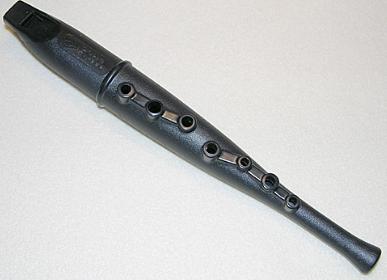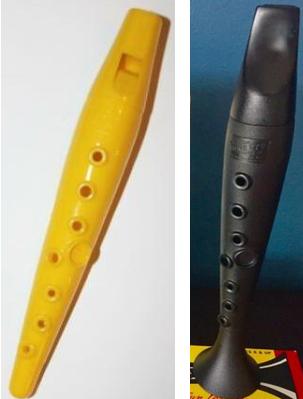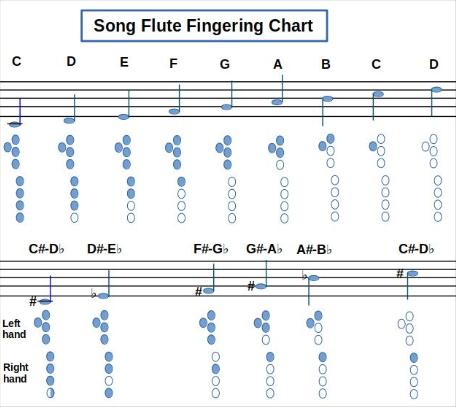

The Ultimate Guide to the Song Flute November 16, 2022
One of the great delights to fluting is that you can play so many different instruments. If you play the concert flute, for example, you can easily adapt to playing various kinds of recorders, penny whistles,
fifes, wood flutes, tonettes, ocarinas, and more. This article describes one of the easiest to play of all flutes: the song flute. Song flutes are simple plastic instruments that are widely used in early musical education. They
lack mechnical keys and have easy-to-reach holes, so they're ideal for
youngsters to learn basic music skills. Many flute, clarinet, and saxophone players started out
with the song flute as their first musical instrument. Given their use with school children, many consider song flutes as little more than musical toys.
But these cheap little instruments -- limited though they may be -- can still be musically interesting.
As we'll demonstrate, you can play beautiful music with them. And, with your adult fluting skills,
you can play one as soon as you pick it up.
The song flute adds a fresh new voice to your repetoire ... no learning curve required. Free sheet music included, it's all available for the cost of a meal. This article tells you everything you'd ever want to know about this versatile little flute. Song flutes were invented in the late 1930s by Elver
Fitchhorn. They're sometimes called the "Fitchhorn Flute."
Song flutes carry
the stamped identifier "Song Flute" and/or the makers mark
of Fitchhorn, Selmer, Conn-Selmer, or Conn. The instruments were widely popular for early music
education from the 1930s through the 1970s. Though they're still employed today, their
popularity tailed off with the
introduction of high-quality plastic recorders in the '70s
and '80s. Recorders are definitely more difficult to play but are also unquestionably
more musically capable. The song flute consists of a single piece of molded
plastic. This makes it very inexpensive, but there's also a
downside. First off, you can't tune it.
And for cleaning it is less convenient than flutes that offer
removable mouthpieces. You wash it by full immersion in
soapy warm water. Like the Model T Ford, song flutes come in every color
you might want... so long as that color is black. Here are a couple song flutes: (Photos courtesy of Amazon
and the The OnMusic Dictionary)
People often confuse the song flute with the tonette,
a competing plastic flute that comes in many colors but is
also most often seen in black. Though they share many similarities
-- such as key and fingering -- song flutes and tonettes
are different instruments. Each has its unique voice. (For more on the
tonette, read my companion article
The Ultimate Guide to the Tonette).
You can see that the tonette lacks the song flute's
gently expanding tail, as well as its distinctive raised
paths between the finger holes. Here are two tonettes: (Photos courtesy of vendor iclaura at eBay
and Gibson)
I've claimed that the simple song flute offers a voice worthy of your interest,
so before going any further, let's listen to a
few sound clips. Each was recorded using a different instrument and microphone: The song flute's slightly airy voice projects best
within a resonant environment, such as a hallway,
stairwell, or basement. A bit of natural reverb enhances
its acoustics. I enjoy playing my song flute in the
stairwell that leads to my unfinished basement.
Playing this little flute is simplicity itself. You needn't bother about a reed,
nor must you spend days learning how to blow into it
properly, as you likely did with your concert flute. Simply put your mouth on the fipple and blow. To play an
ascending scale, cover all holes with your fingers and
progressively lift each finger. You'll notice the raised
holes are easier to cover than a recorder's. The flute's range is only a scale plus a note, from C5
through D6. That's its main limitation -- and it's a big one. Concert woodwinds
play from two-and-one-half to well over three full octaves. Even
folk flutes like recorders and tin whistles (penny whistles)
range over two full octaves. You can play all sharps and flats within the
instrument's range by cross-fingering (sometimes referred
to as forked or split fingering).
There is one exception: playing low C# requires
half-holing the bottom-most hole. That's no problem for
experienced players but it challenges beginners. Here's a fingering chart: Alternate fingerings exist for several notes.
Particularly with the sharps and flats you should
experiment with your instrument to find what sounds best
for your breath pressure. The song flute's C5 base note is one octave above middle
C on the piano. That's the same base note as the soprano recorder. It matches many other
folk flutes, including tonette, alto ocarina, and C tin whistle. This means you can play the wealth of free sheet music
downloadable for all those instruments. The song flute's limited range of 9 whole notes
sometimes presents an issue with music written for
other instruments because those instruments have
broader range. You may have to transpose some songs to a
suitable key. A few you may be forced to skip altogether.
Practically speaking, you can play nearly any tune on a
song flute so long as it's in an appropriate key. As far as sheet music goes, here are some websites for downloading free sheet music
you can play on the song flute: Song flutes don't all sound the same. Older ones have a
shiny, glossy appearance. Those from the last several
decades are
non-reflective. They're typically flat black or matte
finish. In my experience, the highly reflective, older material
produces better sound. Perhaps it's denser or reflects
sound waves
differently? Whatever the case, to obtain a great sounding
instrument, stay away from the newer flutes.
Seek out an older, used item from eBay or other reseller. I recommend buying a flute made before 1970. Test it
yourself if at all possible. That's your best assurance
you'll get an instrument
that produces quality sound. Ironically, the market doesn't recognize the tonal
differences among song flutes. You'll pay the same $10 to
$20 for a sweet-sounding instrument as you would for a breathy
kid's toy. Folk flutes like the song flute unleash your creativity with new sounds.
For just a few dollars you can enjoy a portable instrument you can carry in your pocket. Sheet music is free.
And it takes little time to develop the skills necessary to
experience real joy in playing.
What's a Song Flute?



Sound
How to Play

Finding Music
Finding an Instrument
Why Not?

